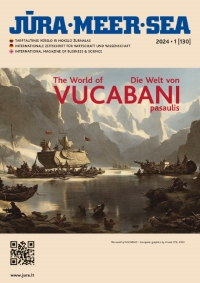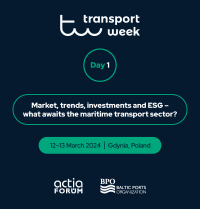At the international conference in Hamburg, scientists, engineers and shipbuilding experts gathered to discuss sustainable deep sea mining as well as opportunities and risks of Arctic shipping. The main focus was on the latest maritime technologies – plus the question: When will the time be right to begin exploiting the resources in the deep blue?
Hamburg, 10/09/2018 – Whether for storage batteries, smartphones or components for innovative on-board equipment: The high-tech industry's demand for rare metals is increasing steadily. As the search for more copper, cobalt and rare earths continues, the industry begins to look beyond traditional frontiers – and into regions such as the deep sea and the Arctic. But how can these riches and resources on the Arctic sea bottom be mined without causing severe environmental damage and exorbitant costs? What innovative maritime technologies available today could be used? And how would all this affect pristine ecosystems?
Answers to these questions where presented at the Offshore Dialogue in Hamburg last week which took place in conjunction with SMM, the leading international maritime trade fair. Under the motto "Pushing the limits – new maritime technologies for future needs”, the distinguished discussion panel explored opportunities and risks as well as potential solutions.
Precious nodules
The first panel discussion, titled "The unknown oceans – exploration for the balance between use and conservation” addressed the coveted deep-sea raw material deposits, among them manganese nodules. These small, black lumps are found strewn across the sea bottom at depths around 5,000 metres. They not only contain manganese but also iron, copper, cobalt and nickel. In his lecture "Component tests for responsible manganese nodules mining – aspects and results", Joury Van Gijseghem, General Manager at DEME Blue Energy, described potential methods of mining these precious nodules. The Belgian Marine technology specialist has experience building equipment for deep sea mining and has tested such equipment from the German research vessel “Sonne”. To minimise any undesirable effects on the environment, Gijseghem called for industry and science to intensify their cooperation. After all, the sea bottom bearing the nodules is considered as ecologically extremely sensitive.
The essential role manganese nodules play for deep-sea biodiversity was portrayed by Prof. Dr. Andrea Koschinsky from Jacobs University Bremen: "Regions with high nodule density are also rich in biodiversity. However, when we study regions where nodules have been mined later on, we find the number of microorganisms greatly reduced." Since the nodules grow by just a few millimetres or centimetres over millions of years, it is important to weigh today's decisions with the greatest care.
Apart from manganese nodules, massive sulphides are objects of industrial desire, as well. Heiko Felderhoff, CEO at Harren+Partner Shipping, presented a process that practically machines magma out of the sea bottom. His proposal was to limit the application of this method to ‘cold’ fields where magma no longer exits from the seafloor and no living organisms exist. “Combining well-proven technologies from civil engineering and the offshore industry, the BAUER-H&P concept provides an all-new approach to Deep Sea Mining that is not only cost-efficient but also flexible and environmentally friendly.”
A hard shell
According to the International Union for Conservation of Nature (IUCN), deep sea regions make up nearly 2/3 of Earth's surface, and many of these regions are uncharted territory. There is currently a great need for state-of-the-art research vessels. In his presentation "Polar research – a ship designer’s perspective", Einar Vegsund, Vice President Ship Design at Rolls-Royce Marine, gave the audience an idea how these high-tech ships for icy environments should be planned. "Such a ship needs more than just power and strength. It must be capable of performing a multitude of functions and withstand the most extreme ambient conditions." The challenge is to find the right balance between all the different aspects, said Vegsund who was responsible for the design of such notable ships as "Kronprins Haakon”: "On-board logistics is the greatest challenge."
The stability of the hull is key since these ships encounter ice several metres thick. The International Maritime Organization (IMO) issued its Polar Code as a mandatory set of rules for these vessels in 2017. Sascha Pristrom, Technical Officer Marine Technology Section at IMO, expects his organisation to take further action to protect the sensitive regions: "The polar code is not the last answer."
Robust and clean
As Teus van Beek, General Manager Market Innovation at the Finnish ship engine manufacturer Wärtsilä, pointed out in his speech, efficiency should not be side-lined when designing polar vessels. His creed: "These ships must be robust and clean." He urged the industry to protect highly sensitive Arctic regions and insist on the use of clean fuels. Doing so is getting ever more important, he added. "The progressing climate change causes a dramatic shrinkage of ice cover around the North Pole," said the British expert Robert Tustin, Consultant Ship New Construction at the ship classification society Lloyd’s Register. "As a consequence, new shipping routes are opening up in the polar region." Just a few weeks ago, the world's leading container ship operator Maersk announced its intention to let more ships travel through the Arctic Ocean.
Ways to design and equip ships specifically for the changing conditions in the Arctic was the subject of a lecture presented by Nils Reimer, Head of Arctic Technology Department at the Hamburg Ship Model Basin: "Brash ice plays a key role. We must account for wave motion on the open ocean and design and equip our ships accordingly."
As the Arctic becomes more accessible, the industry shows growing interest in the mineral deposits in this part of the world. "The Arctic harbours an investment potential of around €172 billion," said Anu Frederikson, Director at the Artic Economic Council (AEC), and moderator of the second panel titled "Heading north – technologies for a responsible development of the Arctic". "We enable business-to-business activities in the Arctic while making sure that resources are developed in a responsible manner. To accomplish this we need the best possible technical support."
This year's cooperation partner of the Offshore Dialogue was the German Association for Marine Technology (GMT). GMT Chairman Dr. Walter Kuehnlein was highly pleased with the outcome of the event: "The Offshore Dialogue has shown that by using carefully selected high-technology equipment, combined with the strictest technological standards, sustainable mining of deposits in the deep sea and the Arctic is possible."
The next SMM will take place from 8 to 11 September 2020 in Hamburg.
Hamburg Messe










